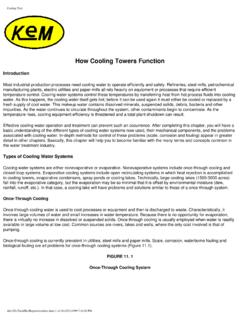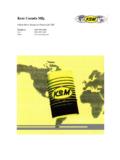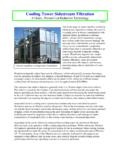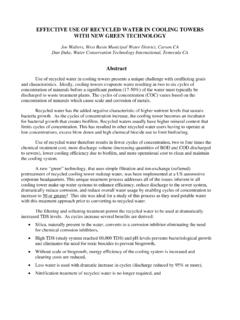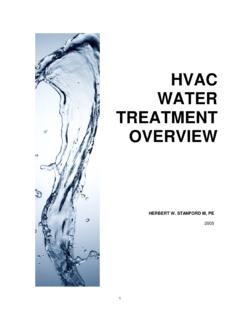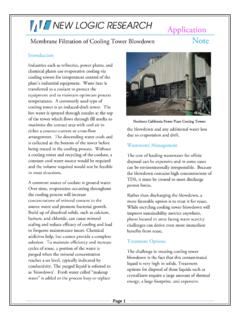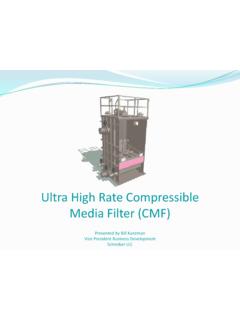Transcription of A Guide to Trouble-Free Cooling Towers - kemmfg.com
1 Maint1A Guide to Trouble-Free Cooling TowersA basic understanding of Cooling tower operation and maintenance will help keep a Cooling water system running in top condition, year after yearBy David M. SupticAir conditioning and refrigeration systems ranging from light commercial to industrial applications may rely on Cooling Towers to remove waste heat. While there are many different types of Cooling Towers and evaporative condensers used with hvacr systems the basic methods of operation and maintenance are fairly common to all of the inherently rugged construction of modern Cooling Towers , proper maintenance is often overlooked until major Cooling system problems develop. Such problems are avoidable if you understand the basic principles of tower operation, and perform periodic inspection and maintenance of the Cooling tower also helps to understand that a Cooling tower is a collection of systems that work together.
2 Here's an overview of how these systems operate:Hot water from the condenser is delivered to the top of the Cooling tower by the condenser pump through distribution piping. The hot water is sprayed through nozzles onto the heat transfer media (fill) inside the Cooling tower. Some Towers feed the nozzles through pressurized piping, others use a water distribution basin and feed the nozzles through gravity. A cold water collection basin at the base of the tower gathers cool water after it has passed through the heat transfer media. The cool water is pumped back to the condenser to complete the Cooling water (1 of 5) [9/25/03 10:46:09 AM]Maint1 Cooling Towers use evaporation to release waste heat from an hvac system. Hot water flowing from the condenser is slowed down and spread out in the heat transfer media (fill).
3 A portion of the hot water is evaporated in the fill area, which cools the bulk water . Cooling tower fill is typically arranged in packs of thin cormgated plastic sheets or, alternately, as splash bars supported in a grid pattern. Large volumes of air flowing through the heat transfer media help increase the rate of evaporation and Cooling capacity of the tower. This airflow is generated by fans powered by electric motors. The Cooling tower fan size and airflow rate are selected for the desired Cooling at the design conditions of hot water , cold water , water flow rate and wet bulb air temperature. Hvac Cooling tower fans may be propeller type or squirrel cage blowers depending on the tower design. Small fans may be connected directly to the driving motor, but most designs require an intermediate speed reduction provided by a power belt or reduction gears.
4 The fan and drive system operates in conjunction with a starter and control unit that provides start/stop and speed Cooling air moves through the fill, small droplets of Cooling water become entrained and can exit the Cooling tower as carry-over or drift. Devices called drift eliminators are used to remove carry-over water droplets. Cooling tower drift becomes an annoyance when the droplets fall on people and surfaces downwind from the Cooling tower. Efficient drift eliminators remove virtually all of the entrained Cooling water droplets from the air quality countsThe water quality system insures the Cooling water remains free of contamination and buildup of dissolved solids. The most basic system includes a makeup water line to replace the water evaporated during Cooling .
5 A water bleed-off or blowdown line, which removes excess dissolved solids from the bulk Cooling water , is also required. Warm water in the Cooling system is a natural habitat for microorganisms. Chemical treatment is required to eliminate this biological growth. Several acceptable biocides are available from water treatment companies for this purpose. It may also be advisable to periodically add additional water treatment chemicals to the Cooling tower to control corrosion, pH (acidity) and hardness. water treatment companies will recommend the best treatment program for your Cooling Towers naturally wash particulate matter from the air that flows through the tower. This solid material can accumulate and deposit in the fill and distribution systems. Removal of suspended and entrained solids can be accomplished through filtration and periodic manual cleaning.
6 Various types of filtering systems are effective for keeping the Cooling water clean and reducing the amount of manual it may seem obvious, the Cooling tower must include a means to support and contain the Cooling water and all the systems described above. The Cooling tower structure and casing may be manufactured from various materials like steel, wood, fiberglass or concrete. The material of choice must resist the effects of water and chemical corrosion, and environmental influences from sun, wind, snow and ice. The design and material selection of the Cooling tower structure significantly affects the (2 of 5) [9/25/03 10:46:09 AM]Maint1service life and cost of the tipsSuccessful Cooling tower operation requires periodic attention and preventive maintenance to each of the major components.
7 All operation and maintenance activities must provide for worker safety. Some safety aspects to consider include:Safe access around the Cooling tower, including all points where inspection and maintenance activities protection around inspection and maintenance surfaces, such as the top of the Cooling of fan motor and circulating pumps during inspection and of workers from exposure to biological and chemical hazards within the Cooling water tower location must prevent Cooling tower discharge air from entering the fresh air intake ducts of any building. The following general operating tips apply to all types of Cooling Towers . Each manufacturer will have procedures that apply to a particular tower design:When starting a new tower, inspect and remove any accumulated debris.
8 Fill the Cooling system with water . Set the makeup water valve during this filling process to the recommended operating water level in the collection basin. Continue filling until the static water depth in the cold water collection basin is at the overflow level. Vent trapped air pockets where possible. Start the circulating pump, adding water as needed to maintain positive pump suction. Balance waterflow following the tower manufacturer's procedure to insure even distribution of hot water to all areas of the fill. Poorly distributed water can lead to air bypass through the fill and loss of tower your water treating company's recommendations regarding chemical addition during startup and continued operation of the Cooling system. Galvanized steel Cooling Towers require special passivation procedures during the first weeks of operation to prevent "white rust.
9 "Before starting the fan motor check the tightness and alignment of drive belts, tightness of mechanical hold-down bolts, oil level in gear reducer drive systems and alignment of couplings. Rotate the fan by hand, insure that blades clear all points of the fan the fan, checking for proper forward rotation. If the fan runs in reverse, switch the connection point of two of the three motor leads. Check the function of the motor control system at all forward speeds and reverse operation, if so equipped. Check for stable operation with no leakage of lubricants from mechanical seals and no excessive vibration in the tower (3 of 5) [9/25/03 10:46:09 AM]Maint1 When the Cooling tower operates without heat from the hvac system, the fan motor may run with amperage above motor nameplate level.
10 Motor amperage will reduce when hot water is circulated over the motor control system is designed to start and stop the fan to maintain return cold water temperature. The fan motor must start and stop no more frequently than four to five times per hour to prevent motor water rate from the Cooling tower should be adjusted to maintain between two to four concentrations of dissolved solids. The table on the previous page shows the minimum blowdown flow rate (as a percentage of Cooling water flow rate) to maintain desired levels of tipsTo keep equipment running trouble free , the following maintenance procedures should be conducted in the time frame indicated:Monthly: Closely observe the operation of the Cooling tower and look for changes in sound or vibration level.
